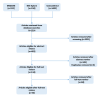Barriers to and Facilitators of Artificial Intelligence Adoption in Health Care: Scoping Review
- PMID: 39207831
- PMCID: PMC11393514
- DOI: 10.2196/48633
Barriers to and Facilitators of Artificial Intelligence Adoption in Health Care: Scoping Review
Abstract
Background: Artificial intelligence (AI) use cases in health care are on the rise, with the potential to improve operational efficiency and care outcomes. However, the translation of AI into practical, everyday use has been limited, as its effectiveness relies on successful implementation and adoption by clinicians, patients, and other health care stakeholders.
Objective: As adoption is a key factor in the successful proliferation of an innovation, this scoping review aimed at presenting an overview of the barriers to and facilitators of AI adoption in health care.
Methods: A scoping review was conducted using the guidance provided by the Joanna Briggs Institute and the framework proposed by Arksey and O'Malley. MEDLINE, IEEE Xplore, and ScienceDirect databases were searched to identify publications in English that reported on the barriers to or facilitators of AI adoption in health care. This review focused on articles published between January 2011 and December 2023. The review did not have any limitations regarding the health care setting (hospital or community) or the population (patients, clinicians, physicians, or health care administrators). A thematic analysis was conducted on the selected articles to map factors associated with the barriers to and facilitators of AI adoption in health care.
Results: A total of 2514 articles were identified in the initial search. After title and abstract reviews, 50 (1.99%) articles were included in the final analysis. These articles were reviewed for the barriers to and facilitators of AI adoption in health care. Most articles were empirical studies, literature reviews, reports, and thought articles. Approximately 18 categories of barriers and facilitators were identified. These were organized sequentially to provide considerations for AI development, implementation, and the overall structure needed to facilitate adoption.
Conclusions: The literature review revealed that trust is a significant catalyst of adoption, and it was found to be impacted by several barriers identified in this review. A governance structure can be a key facilitator, among others, in ensuring all the elements identified as barriers are addressed appropriately. The findings demonstrate that the implementation of AI in health care is still, in many ways, dependent on the establishment of regulatory and legal frameworks. Further research into a combination of governance and implementation frameworks, models, or theories to enhance trust that would specifically enable adoption is needed to provide the necessary guidance to those translating AI research into practice. Future research could also be expanded to include attempts at understanding patients' perspectives on complex, high-risk AI use cases and how the use of AI applications affects clinical practice and patient care, including sociotechnical considerations, as more algorithms are implemented in actual clinical environments.
Keywords: artificial intelligence; artificial intelligence adoption; governance; health care organizations; health information systems; health services; mobile phone; system implementation.
©Masooma Hassan, Andre Kushniruk, Elizabeth Borycki. Originally published in JMIR Human Factors (https://humanfactors.jmir.org), 29.08.2024.
Conflict of interest statement
Conflicts of Interest: AK is editor in chief of
Figures
References
-
- 2022 global health care outlook. Deloitte. 2024. May 27, [2024-05-28]. https://www.deloitte.com/global/en/Industries/life-sciences-health-care/... .
-
- Key strategic priorities. CIFAR. [2022-02-15]. https://cifar.ca/ai/key-strategic-priorities/#topskipToContent .
-
- The age of AI: what exactly is AI? Deloitte Malta. [2024-04-29]. https://www2.deloitte.com/mt/en/pages/rpa-and-ai/articles/mt-age-of-ai-2... .
Publication types
MeSH terms
LinkOut - more resources
Full Text Sources
Medical
Research Materials




